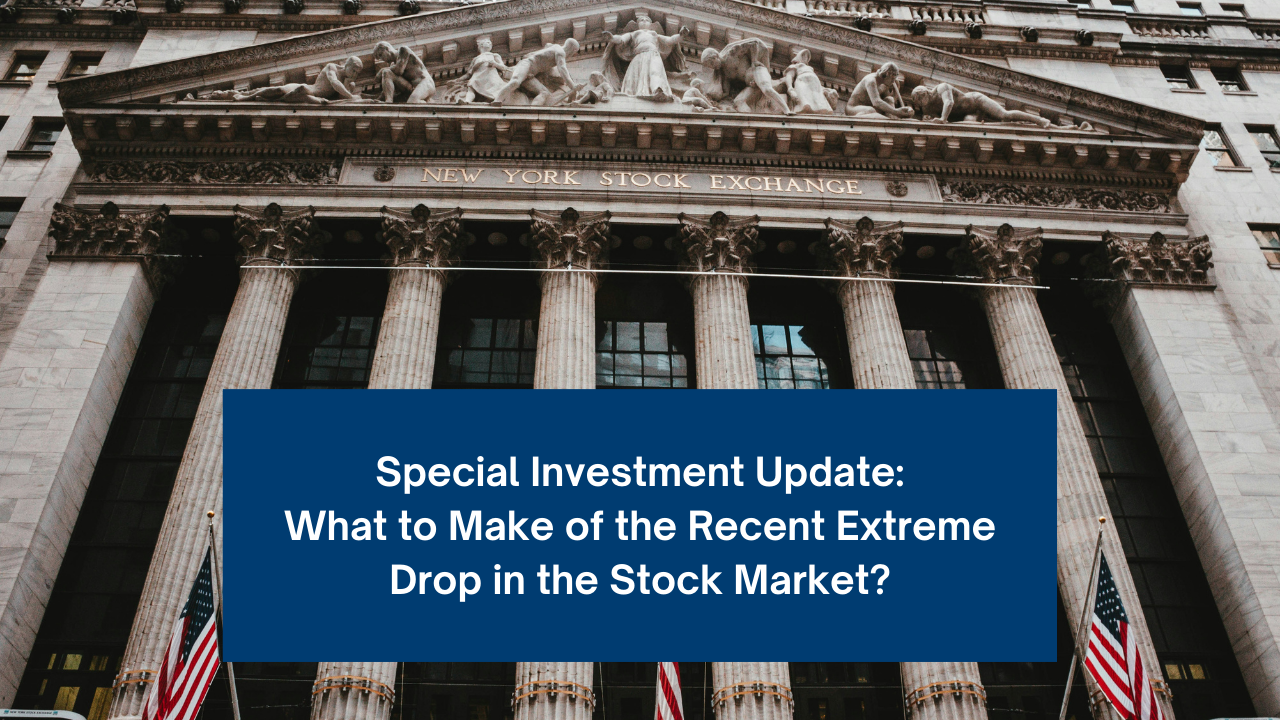Special Investment Update: What to Make of the Recent Extreme Drop in the Stock Market?
The easiest way to explain this recent stock market volatility may be to look at it from the viewpoint of the Federal Reserve (Fed). We believe the stock market is ‘bullying’ the Fed to make a rate policy change similar to what transpired in the stock market in the fourth quarter of 2018:
The Fed at that time was on a rate hiking campaign as opposed to today’s policy which is projecting a rate decrease at their September meeting. However, the similarities lie in the fact that in 2018 the stock market (a leading economic indicator) was telling the Fed their rate policy was too restrictive with its fourth quarter drop of almost 20% (highlighted in the blue box above).
Although the Fed typically does not acknowledge the stock market being a factor in their policy decisions, their last rate hike in the 2015 to 2018 rate hiking cycle was on December 20, 2018 which coincided closely with the stock market low. Just over one month later (January 30th 2019) the Fed announced it was ready to pause its campaign of steadily hiking rates. Subsequently, the stock market erased nearly all of its losses two months later by mid-March.
The Federal Reserve may need to quickly adjust its policies and take into account the stock market's indication that the economy may be at risk. However, the unique challenge today is that they may have to lower interest rates at a meeting not previously scheduled, and this would occur during an election year.
This entails a higher risk of the Fed’s policy being viewed as politically motivated, in addition to the fact that inflation concerns still need to be considered in making an accommodative policy shift (an issue that was not present during the Fed’s 2018/2019 accommodative policy shift).
These complications explain the adage that history rhymes, but often doesn’t perfectly repeat! With this in mind, let’s move on to how we have prepared for this environment.
How is your portfolio positioned to weather this storm?
In our 2024 Mid-Year Investment Outlook from July 19th, we cautioned that our proprietary risk management system was telling us risks were increasing across capital markets. This has helped us add risk reduction strategies that we felt were a good fit across many clients’ portfolios, primarily models with larger equity allocations.
Additional portfolio construction considerations helping to reduce portfolio volatility are as follows:
Overweight of value sectors and underweight of growth sectors of the stock market across managed portfolios.
Growth sectors such as technology, communications, and consumer discretionary have been the hardest hit during this most recent downturn.
Reduced exposure to mega-cap technology companies using sector ETF’s to eliminate stock overlap across asset managers.
These mega-cap tech companies are part of the growth sectors mentioned above that have been the hardest hit so far.
Focus on high-quality fixed-income in portfolios that have appreciated in value coincident with the market’s drop.
Bond values tend to have an inverse relationship to interest rates and have appreciated recently as rates have dropped.
In most portfolios, we own very little to no lower-quality bonds, which have dropped over this period due to credit concerns.
Alternative assets held in most portfolios such as gold have also aided in reducing overall volatility.
A timely accumulation of cash across portfolios as structured income notes have come due over the past few months.
We have chosen to hold these positions in cash (SWVXX money funds) and short-term bond holdings (VGSH and SHY) that have held steady during this recent stock market drop.
Please contact us with any questions regarding this information as it relates to how we are currently managing your portfolio.
Robert Amato, CFP®, CIMA®
Principal
--------
This article may not be copied, reproduced, or distributed without Compass Wealth Management’s prior written consent.
Compass Wealth Management is a Registered Investment Advisor. Advisory services are only offered to clients or prospective clients where Compass Wealth Management and its representatives are properly licensed or exempt from licensure. This article is solely for informational purposes and is not intended to be relied on as a forecast, research, or investment advice, and is not a recommendation, offer, or solicitation to buy or sell any securities or to adopt any investment strategy. The opinions expressed may change as subsequent conditions vary. The information and opinions contained in this material are derived from proprietary and nonproprietary sources deemed by Compass Wealth Management to be reliable, are not necessarily all-inclusive, and are not guaranteed as to accuracy. Past performance is no guarantee of future results. There is no guarantee that any forecasts made will come to pass. Reliance upon information in this material is at the sole discretion of the reader. Investments involve risks.



